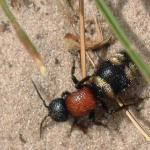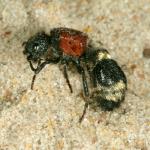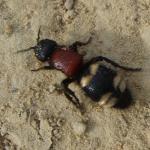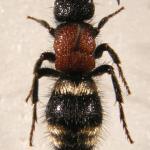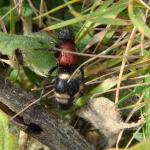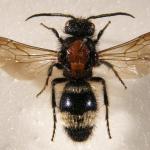This is the larger of the two species of British mutillids (the other being Smicromyrme rufipes). Unlike many aculeate wasps, the female is apterous, a feature which gives it an ant-like appearance, and leads to its being called a 'velvet ant'. The male, however, is fully winged and capable of sustained flight.
Mutilla europaea has a largely disjunct distribution within Britain, being widespread in southern England, absent from much of central England and apparently from the whole of Wales, but found sporadically in northern England and in central Scotland. There are no records from Ireland. The species may be decreasing, and the late G M Spooner (pers. comm.) considered it to be extinct in Cornwall.
Falk (1991) listed the species as Nationally Notable (Nb).
The species is very local, but generally distributed, occurring for example on heaths, moors, chalk grassland and in woodland. It is perhaps most closely associated with lowland heaths, especially in Hampshire (New Forest) and Dorset, where females are often observed as they scuttle across sandy paths. In Dorset many females have been collected using pitfall traps set as part of survey programmes for various terrestrial invertebrates (S P M Roberts, pers. comm.). Care should be taken when handling females as they apparently have painful stings. When disturbed, both sexes stridulate quite loudly. This is achieved by rubbing a raised, median, submarginal tooth (the plectrum) on the underside of tergum 2, over a file of dense, transverse rows of fine ridges at the base of tergum 3.
Mutillid wasps are parasitoids of the resting stages of other insects, including aculeate Hymenoptera, Diptera, Coleoptera and Lepidoptera. M. europaea parasitises various bumblebees (Bombus spp.) and also occasionally enters honey bee (Apis mellifera) hives. Alford (1975) summarised our incomplete knowledge of its biology. The female oviposits inside bee cocoons containing prepupae or young pupae. The Mutilla larva eats these immature stages, then spins a cocoon within that of the host. The size of the emerging wasp depends partly on the size of its host: Mutilla emerging from honey bee cells are generally smaller than those from bumblebee cells. On emergence, the adult Mutilla feeds on the host honey stores. Females overwinter as adults, but males leave the host nest soon after emergence and do not survive beyond the autumn. Females sometimes remain in the host nest throughout the winter. This is not always the case, however, in late March 1973, D Appleton found two hibernating females at the roots of low herbage on a chalk grassland site in southern Hampshire.
Males are occasionally found taking nectar from flowers such as wild parsnip. Females do not usually visit nectar sources, though a very small individual was found by S P M Roberts on common fleabane blossom in Dorset.
1997


